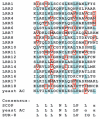SCOP/PHLPP and its functional role in the brain
- PMID: 20024065
- PMCID: PMC3487473
- DOI: 10.1039/b911410f
SCOP/PHLPP and its functional role in the brain
Abstract
SCOP (suprachiasmatic nucleus (SCN) circadian oscillatory protein) was originally identified in 1999 in a differential display screen of the rat SCN for genes whose expression were regulated in a circadian manner (K. Shimizu, M. Okada, A. Takano and K. Nagai, FEBS Lett., 1999, 458, 363-369). The SCN is the principle pacemaker of the circadian clock, and expression of SCOP protein in the SCN was found to oscillate, increasing during the subjective night, even when animals were housed in constant darkness. SCOP interacts with and inhibits multiple proteins important for intracellular signaling, either by directly binding to K-Ras or by dephosphorylating p-Akt and p-PKC. Since the functions of K-Ras, Akt, and PKC are considerably divergent, SCOP may have several roles. We recently discovered that SCOP participates in the formation of long-term hippocampus-dependent memories, and other investigators have examined its role in cell proliferation and survival. In this review, we introduce SCOP from its molecular structure to its physiological functions, focusing mainly on its role in ERK1/2 activation and memory consolidation.
Figures





Similar articles
-
Suprachiasmatic nucleus circadian oscillatory protein, a novel binding partner of K-Ras in the membrane rafts, negatively regulates MAPK pathway.J Biol Chem. 2003 Apr 25;278(17):14920-5. doi: 10.1074/jbc.M213214200. Epub 2003 Feb 19. J Biol Chem. 2003. PMID: 12594205
-
SCOP, a novel gene product expressed in a circadian manner in rat suprachiasmatic nucleus.FEBS Lett. 1999 Sep 24;458(3):363-9. doi: 10.1016/s0014-5793(99)01190-4. FEBS Lett. 1999. PMID: 10570941
-
Proteolytic degradation of SCOP in the hippocampus contributes to activation of MAP kinase and memory.Cell. 2007 Mar 23;128(6):1219-29. doi: 10.1016/j.cell.2006.12.047. Cell. 2007. PMID: 17382888 Free PMC article.
-
Constitutive activation of ras in neurons: implications for the regulation of the mammalian circadian clock.Chronobiol Int. 2006;23(1-2):191-200. doi: 10.1080/07420520500521970. Chronobiol Int. 2006. PMID: 16687293 Review.
-
The cholinergic system, circadian rhythmicity, and time memory.Behav Brain Res. 2011 Aug 10;221(2):466-80. doi: 10.1016/j.bbr.2010.11.039. Epub 2010 Nov 27. Behav Brain Res. 2011. PMID: 21115064 Review.
Cited by
-
Postnatal calpeptin treatment causes hippocampal neurodevelopmental defects in neonatal rats.Neural Regen Res. 2019 May;14(5):834-840. doi: 10.4103/1673-5374.249231. Neural Regen Res. 2019. PMID: 30688269 Free PMC article.
-
Hyperoside Protected Against Oxidative Stress-Induced Liver Injury via the PHLPP2-AKT-GSK-3β Signaling Pathway In Vivo and In Vitro.Front Pharmacol. 2020 Jul 17;11:1065. doi: 10.3389/fphar.2020.01065. eCollection 2020. Front Pharmacol. 2020. PMID: 32765271 Free PMC article.
-
Downregulation of PHLPP expression contributes to hypoxia-induced resistance to chemotherapy in colon cancer cells.Mol Cell Biol. 2013 Nov;33(22):4594-605. doi: 10.1128/MCB.00695-13. Epub 2013 Sep 23. Mol Cell Biol. 2013. PMID: 24061475 Free PMC article.
-
Turning off AKT: PHLPP as a drug target.Annu Rev Pharmacol Toxicol. 2014;54:537-58. doi: 10.1146/annurev-pharmtox-011112-140338. Annu Rev Pharmacol Toxicol. 2014. PMID: 24392697 Free PMC article. Review.
-
Synchrony and desynchrony in circadian clocks: impacts on learning and memory.Learn Mem. 2015 Aug 18;22(9):426-37. doi: 10.1101/lm.038877.115. Print 2015 Sep. Learn Mem. 2015. PMID: 26286653 Free PMC article. Review.
References
-
- Gao T, Furnari F, Newton AC. Mol. Cell. 2005;18:13–24. - PubMed
-
- Brognard J, Sierecki E, Gao T, Newton AC. Mol. Cell. 2007;25:917–931. - PubMed
-
- Shimizu K, Okada M, Takano A, Nagai K. FEBS Lett. 1999;458:363–369. - PubMed
-
- Shimizu K, Okada M, Nagai K, Fukada Y. J. Biol. Chem. 2003;278:14920–14925. - PubMed
Publication types
MeSH terms
Substances
Grants and funding
LinkOut - more resources
Full Text Sources
Miscellaneous

